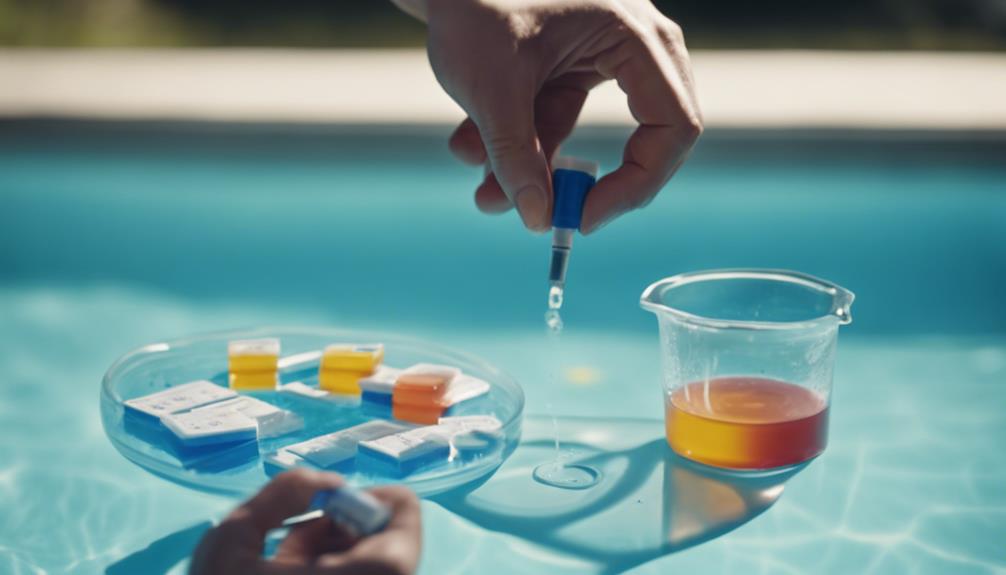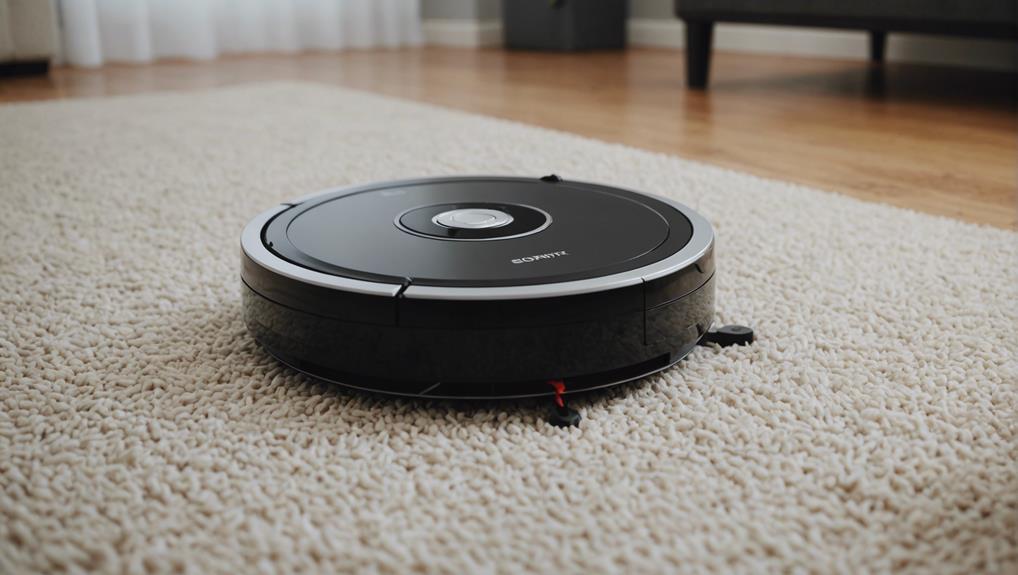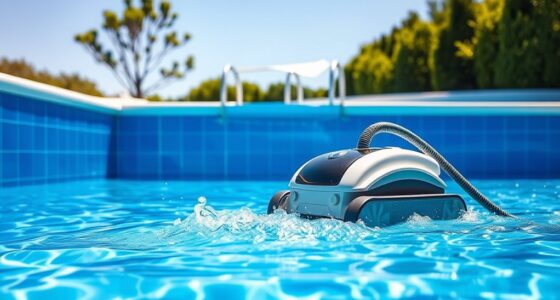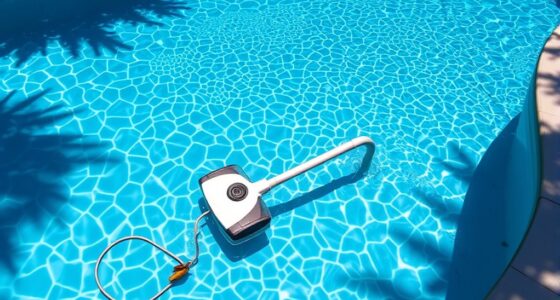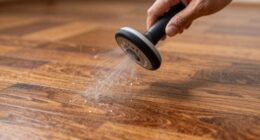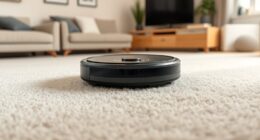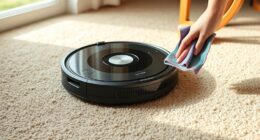To keep your pool in good condition, it’s crucial to maintain the correct chemical balance. Make sure to test the water regularly using reliable kits, especially during peak season. Adjust the Total Alkalinity by adding sodium bicarbonate until it reaches the recommended level. Aim for a pH range of 7.4 to 7.6 to prevent damage and maintain water clarity. Keep an eye on the calcium hardness to prevent scaling and damage. Cyanuric acid is important for protecting against UV rays and increasing the effectiveness of sanitizers. Consider using bromine tablets for additional sanitizing power, as they last longer than chlorine. Having a good grasp of these basics is essential for a clean pool and safe swimming environment. For more tips on how to keep your pool pristine and enjoyable, consult additional resources.
Key Takeaways
- Maintain balanced pH and Total Alkalinity to prevent staining and equipment damage.
- Test pool water at least twice weekly to ensure chemical levels are stable.
- Adjust Total Alkalinity using sodium bicarbonate or sodium bisulfate as needed.
- Keep pH levels within 7.4-7.6 range for chlorine effectiveness and comfort.
- Monitor and adjust calcium hardness to prevent scaling and equipment damage.
Importance of Pool Water Balance
Maintaining proper pool water balance is essential for the health of your pool and the enjoyment of swimmers. By keeping pH levels and Total Alkalinity in check, you establish a balanced chemical environment that's vital for proper pool maintenance. This balance prevents staining, scaling, and cloudy water, creating a safe and comfortable swimming experience.
Ideal chemical levels not only stabilize pH but also help prevent water-related problems that could damage your pool equipment and surfaces.
Regular water testing is key to maintaining balanced water. Testing frequency and adjustments are necessary to prevent issues and avoid costly repairs in the future. Understanding the importance of water balance is the foundation for effective pool maintenance and enjoyable swimming experiences.
Testing Frequency and Methods
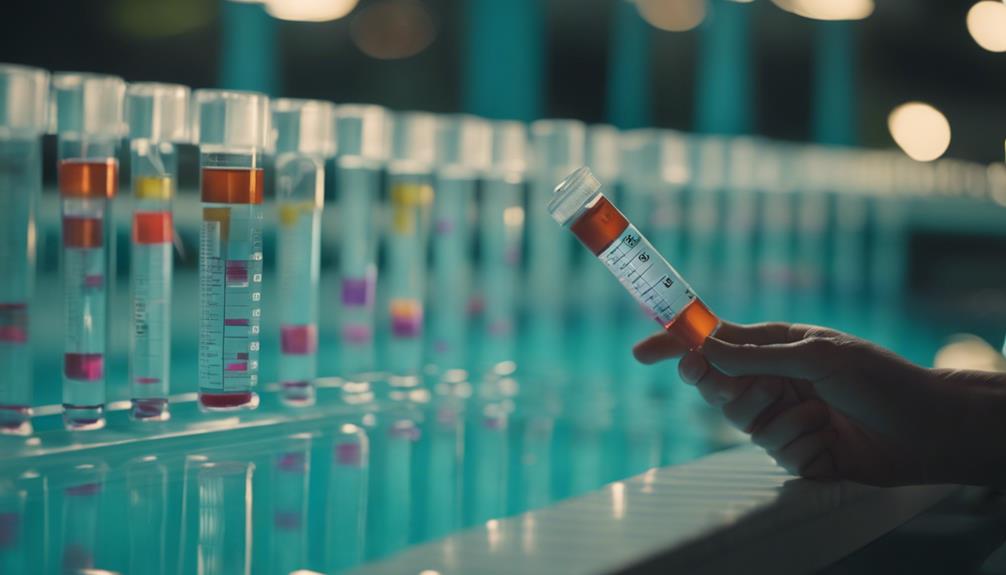
To maintain a balanced pool, it's important to test the water regularly using reliable kits like Taylor K-2005 or ColorQ Pro.
During peak season, aim for at least two tests per week, reducing to once a week during off-peak times.
Consistent monitoring helps prevent equipment damage and guarantees a safe swimming environment for all.
Testing Equipment Needed
Quality testing kits such as the Taylor K-2005 or ColorQ Pro are essential tools for accurately testing your pool water. Regular testing is important to maintain proper water quality. Test key parameters like pH, alkalinity, calcium hardness, cyanuric acid, free chlorine, and total chlorine levels to guarantee a safe swimming environment.
These kits provide convenience for at-home testing. However, it's recommended to have your pool water professionally tested at a store monthly for more thorough analysis. Proper collection of water samples and tracking test results are essential for monitoring pool water chemistry effectively.
Make sure to follow the instructions provided with the testing kit for accurate results. With the right testing equipment and regular monitoring, you can ensure that your pool water remains balanced and safe for you and your family to enjoy.
Recommended Testing Schedule
Perform pool water testing at least twice a week during peak season and once a week in cooler months to guarantee proper chemical balance.
Utilize test kits such as Taylor K-2005 or ColorQ Pro for accurate measurements of pH, alkalinity, calcium hardness, and chlorine levels.
This routine testing helps prevent equipment damage caused by excess chlorine and ensures a safe swimming environment for you and your family.
Remember to adjust chlorine levels based on your pool's usage and the season, especially in cooler months when chlorine demand may be lower.
For precise recommendations on maintaining the chemical balance in your pool water, consider professional testing services.
Adjusting Total Alkalinity

Maintaining the proper level of Total Alkalinity in your pool is essential for ensuring water balance and equipment longevity.
To adjust Total Alkalinity effectively, consider the following:
- Use sodium bicarbonate or baking soda to increase Total Alkalinity levels within the recommended range of 80-120 ppm.
- If Total Alkalinity is high, resulting in elevated pH levels, consider adding sodium bisulfate or muriatic acid to lower it.
Keeping Total Alkalinity at the right levels helps prevent equipment corrosion, promotes water balance, and enhances sanitizer efficiency.
Regularly testing and adjusting Total Alkalinity is vital in maintaining a healthy pool environment.
Balancing Ph Levels
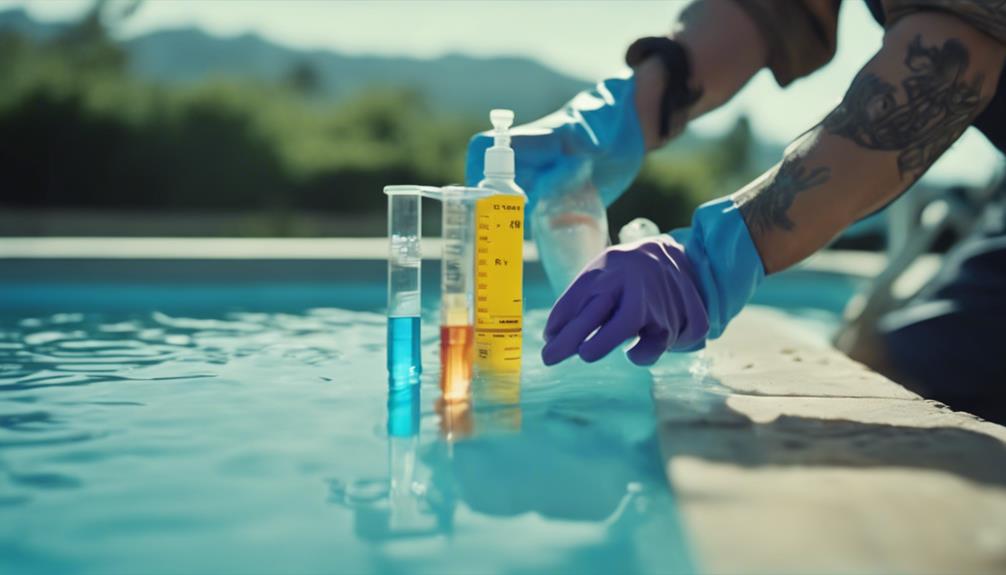
Achieving the ideal pH range of 7.4 to 7.6 is essential for maintaining proper water balance and preventing equipment damage in your pool. Proper pH balance is vital for chlorine effectiveness and swimmer comfort in the pool. Imbalanced pH levels can lead to corrosion of pool surfaces and equipment.
To guarantee a safe and enjoyable swimming environment, regularly test and adjust the pH levels of your pool. Testing kits are readily available and easy to use. If the pH is too low, add a pH increaser; if it's too high, use a pH decreaser.
Keeping the pH within the recommended range not only protects your pool equipment but also helps maintain water clarity and prevents skin and eye irritation. Remember, maintaining the right pH balance is key to a healthy and inviting pool for you and your guests.
Managing Calcium Hardness
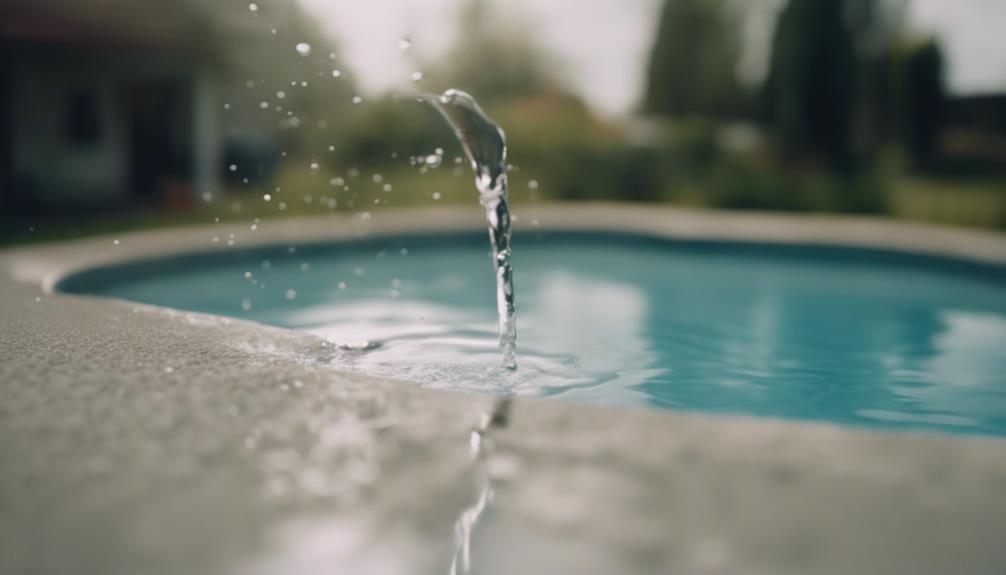
To manage calcium hardness effectively in your pool, monitor and adjust the levels within the recommended range of 200-400 ppm. Maintaining the ideal calcium hardness level is vital for balancing pool water and preventing scale buildup.
Here are some key points to help you manage calcium hardness:
- High Calcium Hardness: Excessively high calcium hardness levels can lead to scaling on pool surfaces and equipment, impacting water clarity and filtration efficiency.
- Lower Calcium Hardness: Conversely, low calcium hardness levels can be damaging to pool surfaces and equipment due to the water's aggressive nature.
- Balancing Technique: Use calcium chloride to increase calcium hardness levels when needed. For excessively high levels, consider dilution or using a flocculant to bring the levels back within the recommended range.
Adding Pool Sanitizers
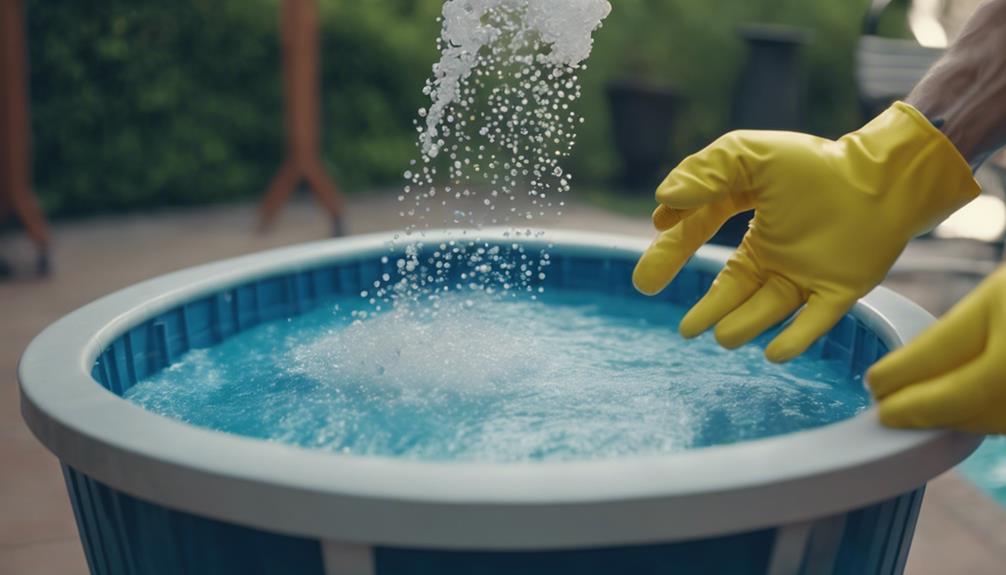
When adding pool sanitizers, remember to choose the right type for your pool, whether it's granules or tablets.
Make sure to apply the sanitizer correctly and maintain it regularly to keep your pool water safe and clean.
Proper Sanitizer Selection
Consider selecting the appropriate sanitizer for your pool based on factors such as your preferences and the specific needs of your pool. When choosing a sanitizer, you can opt for chlorine, bromine, or biguanide based on what suits you best.
Here are some key points to keep in mind:
- Chlorine: Effectively oxidizes contaminants and is a popular choice for pool sanitation.
- Bromine: Remains active for a longer period but can form bromamines which may require additional treatment.
- Stabilized Chlorine: Contains cyanuric acid, ideal for outdoor pools to prolong its effectiveness and protect it from UV rays.
In addition to these options, you may also consider using metals like silver and copper as supplements to chlorine for additional water sanitation in your pool. Each sanitizer has its advantages, so choose wisely based on your pool's specific requirements.
Correct Sanitizer Application
To guarantee effective water sanitation in your pool, make sure to properly apply pool sanitizers like chlorine or bromine. Adding the right amount of sanitizer is essential to maintain proper levels in the pool. Follow the manufacturer's instructions carefully to make certain you're using the correct chemical and quantity.
Regularly test the sanitizer levels and adjust as necessary to keep the water safe and clean for swimming. Consider using stabilized chlorine with cyanuric acid for outdoor pools as it helps prevent rapid breakdown from UV rays, extending its effectiveness.
Maintaining the ideal sanitizer levels is vital to prevent the growth of harmful bacteria and algae in the pool water. By staying diligent with sanitizer application and testing, you can create a healthy swimming environment for you and your family.
Regular Sanitizer Maintenance
Regularly adding pool sanitizers like chlorine or bromine is essential for maintaining clean and safe swimming water by effectively killing contaminants.
When it comes to pool sanitizers, there are a few key points to keep in mind:
- Chlorine is commonly available in granules or tablets, offering flexibility in application methods based on your pool's specific needs and your preferences.
- Stabilized chlorine, which includes cyanuric acid, is particularly beneficial for outdoor pools. It helps protect against UV degradation, extending the sanitizer's effectiveness over time.
- Bromine tablets, on the other hand, contain a small amount of chlorine for extra sanitizing power. They also remain active longer than chlorine, making them a suitable alternative for certain pool setups.
Frequently Asked Questions
How Do You Fix a Chemical Imbalance in a Pool?
To fix a chemical imbalance in your pool, test key levels like alkalinity, pH, calcium hardness, and cyanuric acid. Adjust with specific chemicals like increasers or decreasers. Shock treatments combat bacteria and algae, while dilution helps lower cyanuric acid. Regular maintenance is essential for a safe swimming environment.
What Are the Proper Chemical Readings for a Pool?
Imagine your pool as a delicate ecosystem. To maintain its balance, aim for a pH of 7.4-7.6, Total Alkalinity of 100-150 ppm, Calcium Hardness of 175-225 ppm, Chlorine of 1.0-4.0 ppm, and Cyanuric Acid of 30-100 ppm.
How Long Does It Take to Chemically Balance a Pool?
Balancing your pool chemically typically takes 1-2 days, depending on initial water conditions. Factors like pool size and temperature can affect the process. Professionals may expedite it with advanced equipment and expertise.
What Happens if You Swim in a Pool With Unbalanced Chemicals?
Swimming in a pool with unbalanced chemicals? Your skin and eyes could suffer irritation. Breathing issues might arise from high chlorine levels. Unbalanced pH levels may lead to dry skin. Plus, unbalanced chemicals can harm your swimsuit and pool gear.
What Pool Chemicals Should I Use to Maintain Crystal Clear Water?
When it comes to maintaining crystal clear water in your pool, it’s important to use the right pool chemicals. Stepbystep pool cleaning guide recommends using chlorine to kill bacteria, algaecides to prevent algae growth, and pH balancers to keep the water at the right acidity level. Regular maintenance is key.
Conclusion
Now that you understand the importance of balancing chemicals in your pool, you can immerse yourself in the world of pool maintenance with confidence.
Remember, a well-balanced pool is crucial for crystal clear water and a safe swimming environment.
So grab your test kit, adjust those levels, and watch as your pool transforms into a sparkling oasis. Just don't forget to thank those chemicals for doing all the hard work – they may be invisible, but they sure pack a punch!
